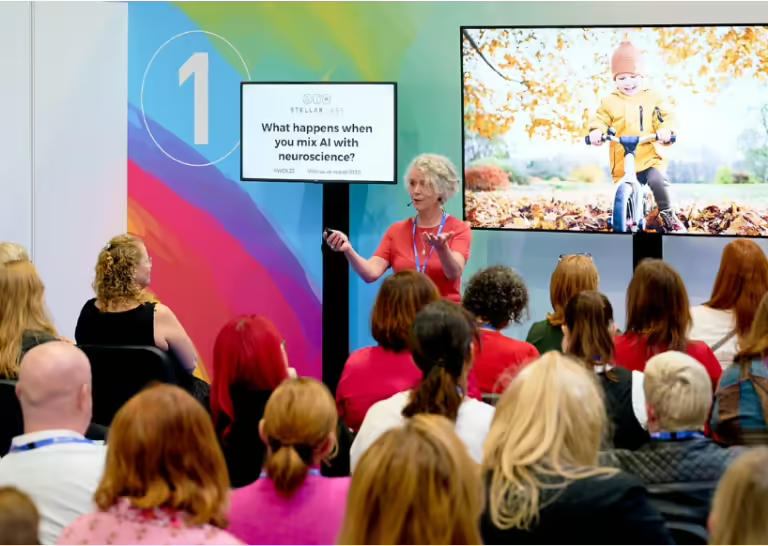Hello, and welcome to this week’s Friday Fresh!
This week, we’re focusing on how Social Learning Theory can be a game-changer for your training design.
Developed by psychologist Albert Bandura, Social Learning Theory emphasises that people learn best through observation, imitation, and modelling. It’s a powerful tool in the world of education, especially when we consider the growing importance of peer learning and interaction.
Let’s explore how incorporating this theory into your course design can increase both engagement and appeal.
What is Social Learning Theory?
At its core, Social Learning Theory argues that much of human learning is a social process. Learners acquire new behaviours, skills, and knowledge by watching others, imitating what they observe, and receiving feedback. This dynamic process emphasises the importance of role models, peer interaction, and the social environment in shaping the learning experience.
But how can we leverage this concept in training design? By fostering interaction, creating opportunities for collaboration, and designing learning activities that make the most of group dynamics, you can make your courses more engaging, relatable, and effective.

Applying Social Learning Theory to Training Design
Here’s how you can apply Social Learning Theory principles to your courses to increase their appeal:
1. Promote Peer-to-Peer Interaction
One of the easiest and most effective ways to apply Social Learning Theory is by encouraging learners to interact with one another. Group work, discussions, and collaborative projects allow learners to observe different perspectives, share ideas, and learn from each other.
Tip: Incorporate activities that require learners to work together, such as group assignments, problem-solving tasks, or peer feedback sessions.
2. Use Role Models and Demonstrations
Learners often look up to those with expertise in their field. By providing real-life role models (whether that’s an industry expert, an instructor, or a successful peer) you give learners someone to emulate. Demonstrations can also show learners exactly how to apply concepts in practice, making the learning experience more concrete.
Tip: Incorporate video demonstrations or invite guest speakers to share their expertise. Seeing the skills they’re learning in action will motivate learners to follow suit.

3. Incorporate Social Media and Digital Communities
Social learning can extend beyond the physical classroom. Platforms like discussion boards, chat groups, or private social media communities allow learners to connect, share insights, and discuss the course content in an informal setting.
Insight: Create a space where learners can continue the conversation outside of structured sessions. Whether it’s a Slack channel, a LinkedIn group, or an online forum, these digital communities encourage continuous learning and foster a sense of belonging.
4. Leverage Observational Learning
Observational learning (learning by watching others) is a key principle of Social Learning Theory. When learners observe others successfully completing a task or applying a skill, they are more likely to believe they can do it themselves.
Tip: Incorporate case studies, live demonstrations, or “day in the life” videos that showcase others applying the skills you’re teaching. This helps learners visualise how they can use the knowledge in real-world scenarios.

5. Create Opportunities for Feedback and Reflection
Social Learning Theory stresses the importance of feedback in the learning process. When learners receive constructive feedback, they can refine their skills and improve performance. In addition, self-reflection helps them assess their own progress and adjust their behaviours accordingly.
Tip: Build in peer feedback loops where learners assess each other’s work, provide feedback, and reflect on their own learning. This reinforces the learning process and encourages accountability.
6. Encourage Mentoring or Buddy Systems
Mentorship or buddy systems pair less experienced learners with more knowledgeable peers. This dynamic enables new learners to observe and model the behaviours of their mentors while giving the mentors an opportunity to teach, which further reinforces their own understanding.
Insight: Consider implementing a mentor or buddy system within your courses. It helps create a supportive learning environment, encourages sharing of knowledge, and increases confidence in both parties.

7. Foster a Learning Culture
Creating a culture where learning from one another is encouraged and expected can significantly boost the appeal of your course. When learners see that it’s not just about individual progress but also about contributing to the group’s knowledge, they feel more invested.
Tip: Celebrate collaborative efforts and the sharing of ideas. Highlight learner contributions to discussions or projects in a public way, like in newsletters or virtual meetings, to show that their input matters and enhances the collective learning experience.
How Social Learning Theory Enhances Course Appeal
Here are the key reasons why applying Social Learning Theory can make your course more appealing:
Increases Engagement: Learners are more likely to engage when they can observe and interact with others. Learning becomes a shared journey rather than an isolated experience.
Builds a Learning Community: By fostering collaboration and communication, you create a sense of community among learners, which increases motivation and commitment to the course.
Encourages Practical Application: Learners gain confidence by observing how others apply skills and concepts in practical settings, making the material feel more relevant and attainable.
Motivates Through Role Models: Role models and peer success stories inspire learners, giving them a tangible example of how they can achieve similar goals.
Final Thoughts
Incorporating Social Learning Theory into your training design is a powerful way to enhance both the appeal and effectiveness of your courses. By encouraging collaboration, providing opportunities for observation, and creating a learning culture that thrives on shared experiences, you can engage your learners in a deeper, more meaningful way.
Remember, learning is often a social activity, and by tapping into this natural inclination, you can create courses that not only impart knowledge but also build community, motivation, and long-term success.






